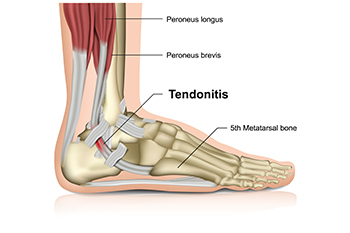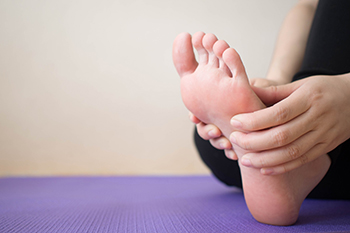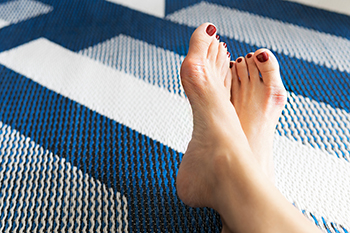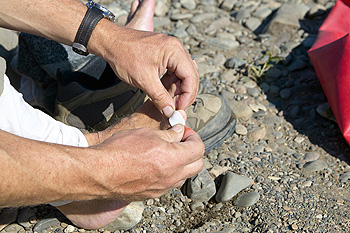
Wilmington (937) 382-2347
Fax
(513) 932-1606

Wilmington (937) 382-2347
Fax
(513) 932-1606

Anyone who has experienced an Achilles tendon injury is all too familiar with the intense pain this condition can cause. This is considered to be the largest tendon in the body, and its function is to connect the calf muscles to the heel. It is responsible for pushing off while walking, running, and jumping, in addition to pointing and flexing the foot. Many patients have heel pain with this type of injury, and it can happen from overuse. People who increase speed and mileage too quickly while running may be prone to a partial or fully ruptured Achilles tendon. Additionally, it may happen from standing on uneven surfaces for most of the day, or possibly from wearing shoes that do not fit correctly. This may help to weaken the tendon, and may gradually lead to the development of this type of injury. The symptoms can include tenderness in the calf and heel area, and it is often difficult to walk. It typically takes several months for this type of injury to completely heal and lifestyle changes may need to occur to avoid stress on the Achilles tendon. If you suffer from an Achilles tendon injury, it is strongly advised that you seek the counsel of a podiatrist who can offer you the correct treatment practices.
Achilles tendon injuries need immediate attention to avoid future complications. If you have any concerns, contact Dr. Gerald Perelman of Ohio. Our doctor can provide the care you need to keep you pain-free and on your feet.
What Is the Achilles Tendon?
The Achilles tendon is a tendon that connects the lower leg muscles and calf to the heel of the foot. It is the strongest tendon in the human body and is essential for making movement possible. Because this tendon is such an integral part of the body, any injuries to it can create immense difficulties and should immediately be presented to a doctor.
What Are the Symptoms of an Achilles Tendon Injury?
There are various types of injuries that can affect the Achilles tendon. The two most common injuries are Achilles tendinitis and ruptures of the tendon.
Achilles Tendinitis Symptoms
Rupture Symptoms
Treatment and Prevention
Achilles tendon injuries are diagnosed by a thorough physical evaluation, which can include an MRI. Treatment involves rest, physical therapy, and in some cases, surgery. However, various preventative measures can be taken to avoid these injuries, such as:
If you have any questions please feel free to contact our office located in Wilmington, OH . We offer the newest diagnostic tools and technology to treat your foot and ankle needs.

The plantar fascia is located on the sole of the foot and it connects the toes to the heels. Some patients may experience a growth that develops inside the plantar fascia, which is often benign. This is referred to as a plantar fibroma that might cause pain while walking and running. It is noticeable by the lump that forms on the bottom of the foot, generally in the center of the arch. The majority of experts agree it occurs due to genetic reasons or medical conditions like epilepsy, diabetes, and alcoholism. Other people can argue a plantar fibroma may develop after an injury occurs to the plantar fascia and the lump may be a natural reaction to the stress from the trauma. Mild relief may be found when the shoes that are worn have extra cushioning, or it may be beneficial to wear custom-made orthotics. If you have developed this condition it is advised that you are under the care of a podiatrist who can provide the treatment options that are correct for you.
A plantar fibroma may disrupt your daily activities. If you have any concerns, contact Dr. Gerald Perelman of Ohio. Our doctor can provide the care you need to keep you pain-free and on your feet.
Plantar Fibroma
A plantar fibroma is a fibrous knot in the arch of the foot. It is embedded in the plantar fascia which is a band of tissue that extends from the heel to the toes along the bottom of the foot. There can be multiple plantar fibromas in the feet at the same time. There are no known causes for this condition. If you have a plantar fibroma, there will be a bump in the arch of your foot that cannot be missed. Any associated pain is most often due to a shoe rubbing against the nodule. Non-surgical options, such as steroid injections, physical therapy, and orthotics should be tried first. Surgery is a last resort and is the only thing that will remove a plantar fibroma entirely. Consult with a podiatrist for a proper diagnosis and to determine the treatment regimen that is right for you.
What Causes a Plantar Fibroma?
While there are no specific causes identified, a plantar fibroma can possibly come from genetic predisposition or the formation of scar tissue that forms from healing the tears in the plantar fascia.
What Are the Symptoms of a Plantar Fibroma?
There will be a noticeable lump in the arch of the foot that may or may not cause pain. If pain is felt, it is typically because a shoe is rubbing up against the lump or when walking or standing barefoot.
Treatment and Prevention
A plantar fibroma will not disappear without treatment, but it can get smaller and be a non-issue. If pain persists, a podiatrist examines the foot and when the arch of the foot is pressed, pain can be felt down to the toes. An MRI or biopsy might be performed to help diagnose or evaluate the plantar fibroma. The following non-surgical options are generally enough to reduce the size and pain of these nodules:
Surgery is considered if the mass increases in size and the patient continues to feel pain after non-surgical methods are tried.
If you have any questions please feel free to contact our office located in Wilmington, OH . We offer the newest diagnostic tools and technology to treat your foot and ankle needs.

A bunion is a deformity of the joint at the base of the big toe. Bunions develop when the first metatarsal bone of the foot turns outward and the big toe points inward toward the other toes. This causes the joint to extend out from the foot. A bunion can become painful and interfere with walking and exercising as the joint becomes inflamed. It can be difficult to find shoes that accommodate a bunion, and it is best to avoid any additional pressure on the misaligned joint. Women are more likely to develop bunions because they tend to wear narrow shoes and high heels. Bunions can also be genetic and may result due to abnormal foot structures and shapes. Those with low arches and loose joints or tendons, as well as people who stand on their feet for prolonged periods, are also at increased risk for developing bunions. If you have a painful bunion, it is suggested you see a podiatrist who can provide alternative treatment options to help you live more comfortably.
If you are suffering from bunion pain, contact Dr. Gerald Perelman of Ohio. Our doctor can provide the care you need to keep you pain-free and on your feet.
What Is a Bunion?
Bunions are painful bony bumps that usually develop on the inside of the foot at the joint of the big toe. As the deformity increases over time, it may become painful to walk and wear shoes. Women are more likely to exacerbate existing bunions since they often wear tight, narrow shoes that shift their toes together. Bunion pain can be relieved by wearing wider shoes with enough room for the toes.
Causes
Symptoms
In order to diagnose your bunion, your podiatrist may ask about your medical history, symptoms, and general health. Your doctor might also order an x-ray to take a closer look at your feet. Nonsurgical treatment options include orthotics, padding, icing, changes in footwear, and medication. If nonsurgical treatments don’t alleviate your bunion pain, surgery may be necessary.
If you have any questions, please feel free to contact our office located in Wilmington, OH . We offer the newest diagnostic and treatment technologies for all your foot care needs.

Blisters on the feet are pockets of fluid that form beneath the top layer of the skin to protect the lower layers from damage. Blisters on the toes, feet, or heels may be caused by friction, usually from pressure or rubbing against the inside of a shoe. Generally, a blister is filled with clear serum, but sometimes it may be filled with blood, or even pus if it becomes infected. As a rule, a blister will go away on its own in three to seven days. As new skin grows under the blister the serum will be reabsorbed into the body and the outer skin will dry up and flake off. However, it is important to remember that popping a blister can cause infection or inhibit the healing process. Wearing shoes that are comfortable and do not rub against the skin is a sure way of allowing a blister on the foot to heal, or preventing one from occurring in the first place. If you have a particularly painful blister, or one that appears to be infected, please make an appointment with a podiatrist. Antibiotics may be prescribed to ward off the infection, and the podiatrist may safely drain the blister in a sterile setting.
Blisters may appear as a single bubble or in a cluster. They can cause a lot of pain and may be filled with pus, blood, or watery serum. If your feet are hurting, contact Dr. Gerald Perelman of Ohio. Our doctor can provide the care you need to keep you pain-free and on your feet.
Foot Blisters
Foot blisters are often the result of friction. This happens due to the constant rubbing from shoes, which can lead to pain.
What Are Foot Blisters?
A foot blister is a small fluid-filled pocket that forms on the upper-most layer of the skin. Blisters are filled with clear fluid and can lead to blood drainage or pus if the area becomes infected.
Symptoms
(Blister symptoms may vary depending on what is causing them)
Prevention & Treatment
In order to prevent blisters, you should be sure to wear comfortable shoes with socks that cushion your feet and absorb sweat. Breaking a blister open may increase your chances of developing an infection. However, if your blister breaks, you should wash the area with soap and water immediately and then apply a bandage to the affected area. If your blisters cause severe pain it is important that you call your podiatrist right away.
If you have any questions, please feel free to contact our office located in Wilmington, OH . We offer the newest diagnostic and treatment technologies for all your foot care needs.